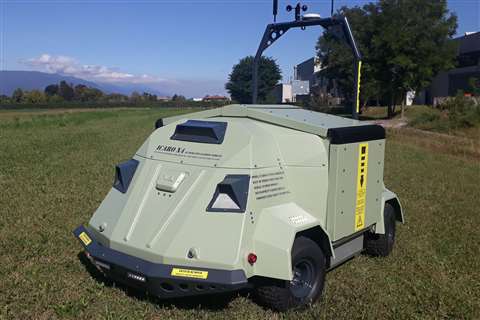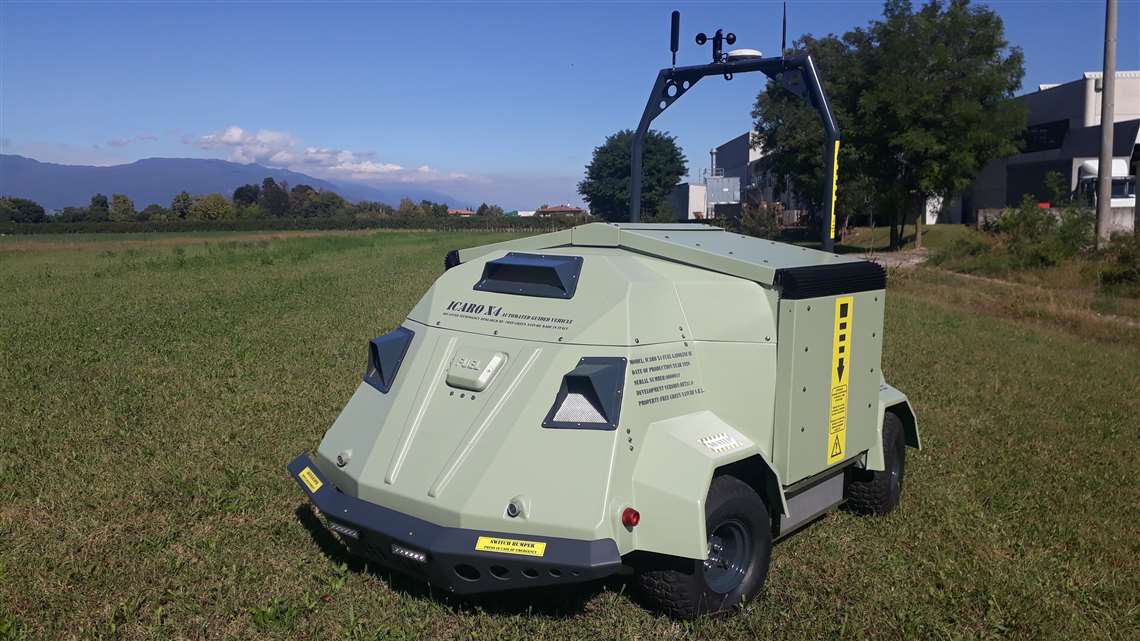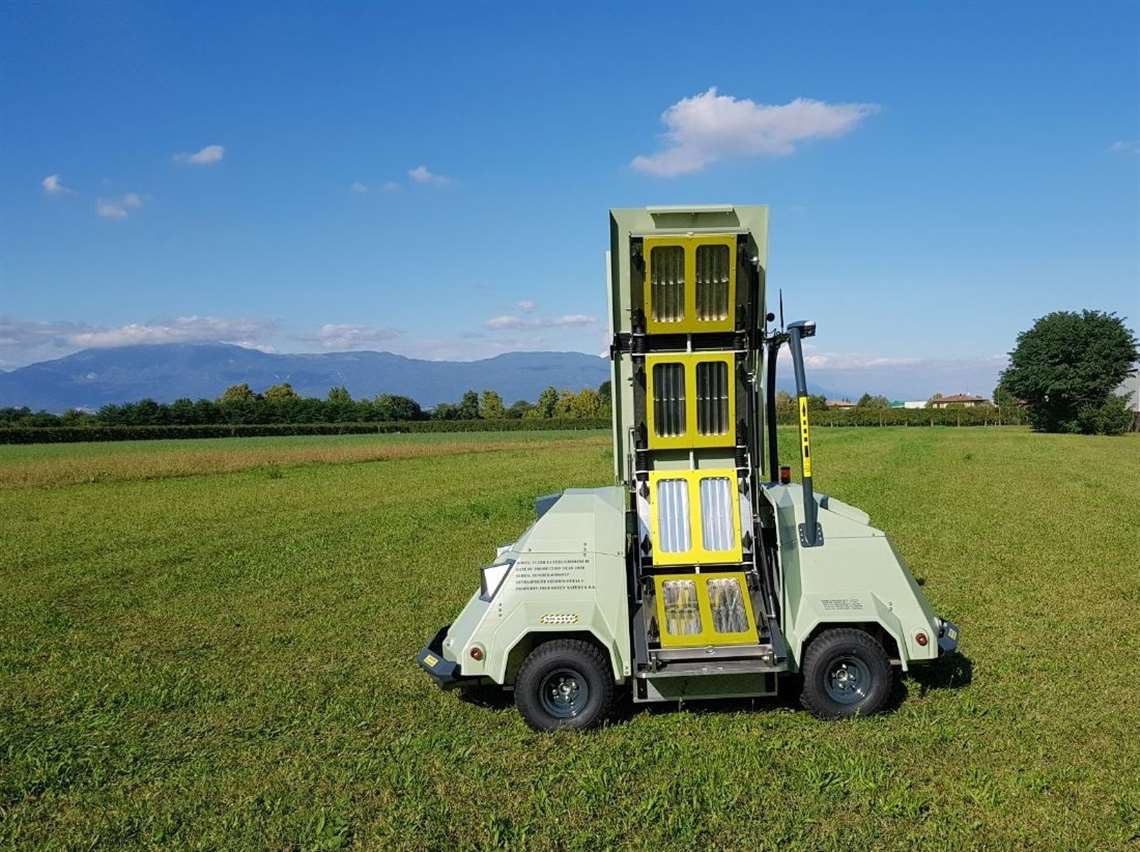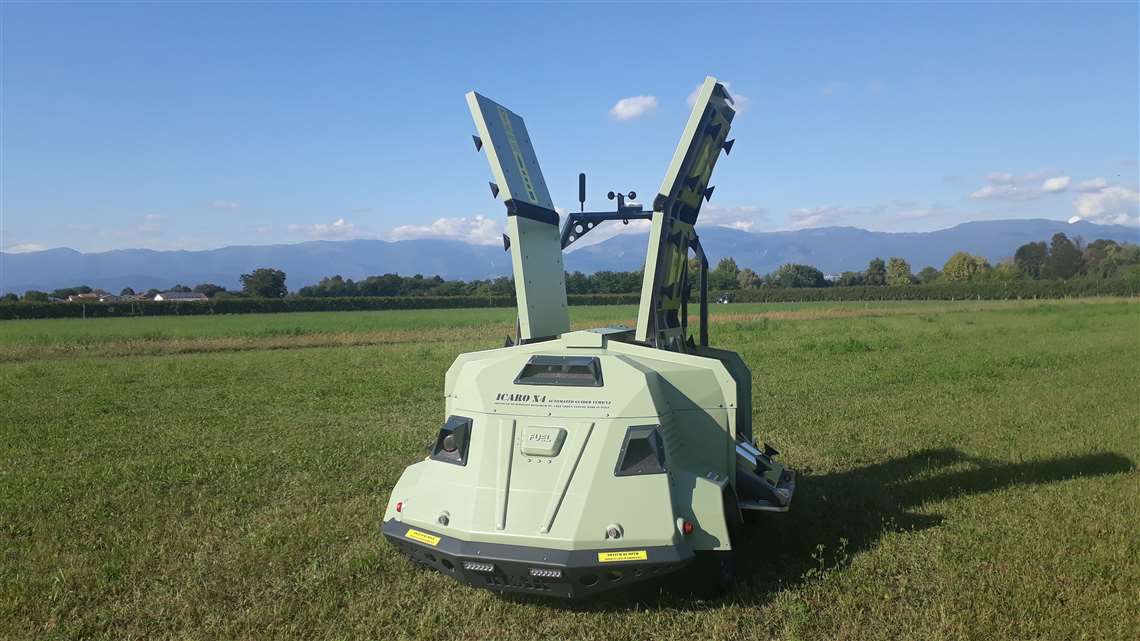
A Light Touch For Vineyards
25 January 2021
Autonomous Icaro X4 robotic vehicle uses ultraviolet light to rid vines of mildew and fungi.
By Mike Brezonick
Keeping a vineyard healthy can be a significant challenge. Besides the exigences of weather and insects, grapevines can also be infected by a range of mildews and fungi that can damage vines and grapes. At the same time, viticulturalists, like nearly all farmers, are looking to reduce the amount of chemicals used in their fields.
 Italian startup Free Green Nature has developed the Icaro X4 robotic vehicle that uses ultraviolet light, rather than chemicals, to rid vineyards of pests such as mildews and fungi.
Italian startup Free Green Nature has developed the Icaro X4 robotic vehicle that uses ultraviolet light, rather than chemicals, to rid vineyards of pests such as mildews and fungi.
To address these challenges, Free Green Nature S.R.L., a startup company in Treviso, Italy, dedicated to the development of advanced precision farming systems, has developed a unique solution – the Icaro X4, an engine-driven, autonomous robot that uses ultraviolet rays to eliminate mildews and other growth that can reduce grapevine growth as well as grape yield and quality.
“The goal we set from the beginning was to eliminate as much as possible the use of pesticides in agriculture, without really looking at the economic return,” said Free Green Nature R&D Director Valter Mazzarolo, who co-founded the company with Guido Tarticchio. “Our aim was to succeed!
“So our R&D team signed an agreement with the CREA research institute in Conegliano, near Treviso, where one of the main Italian experts in viticulture – Prof. Diego Tomasi – contributed his massive experience to our research and created a working group with agronomists and biologists that worked at the optimization of the values for pest treatment.”
ILLUMINATING SOLUTION
The solution the group hit upon was to illuminate the grape plants with ultraviolet rays, which effectively kills mildews and other harmful growth. To apply the UV light in the field, Free Green Nature turned to a small robotic vehicle that had originally been developed by another company owned by Tarticchio.
The robotic vehicle has two air-cooled engine options, both provided by Kohler. The diesel option is a 441 cc, single-cylinder KD15-440 engine rated 10.1 hp at 3600 rpm, while the gasoline engine option is a 429 cc Command Pro ECH440 EFI engine rated 14 hp at 3600 rpm.
The engine drives a small generator that powers four brushless electric motors that operate an electronically controlled differential and four geared, steerable drive wheels that enable the vehicle to turn within a 90° radius.
 The ultraviolet light arrays on the Icaro X4 robot are housed in side panels that extend and retract from the body of the vehicle.
The ultraviolet light arrays on the Icaro X4 robot are housed in side panels that extend and retract from the body of the vehicle.
The electronic control of the vehicle and the ultraviolet light arrays are managed by a proprietary system composed of 32 microprocessors, controlled and monitored by telemetry. The vehicle also mounts GPS, LTE and LoRan antennae, gyroscopes and a proprietary safety system for when the robot moves over potentially dangerous areas, such as roads or bridges.
To operate the Icaro X4, the farmer turns the starter key and presses a button on a touch screen. “Everything else is done autonomously,” Mazzarolo said, “with the robot managed via telemetry by an LTE modem that sends an alert when it is time for refueling.
“All operating data can be accessed via a webpage, where all parameters can be all monitored as well, as for example actual positioning or eventual failures. Our company’s technical service monitors operations continuously too.”
There are a range of safety systems onboard Icaro X4: four lateral thermal imaging cameras to detect people moving at the sides; four ultrasonic sensors for each direction of travel; two 27 GHz radars to detect obstacles ahead; four electromechanical brakes for immediate stopping; two electromechanical tilting bumpers to mitigate collisions; and two WireGuard antennae to stop the robot in case of interrupted navigation in dangerous areas.
 The Icaro X4 robotic vehicle is designed for use on areas up to 24 acres with even terrain and mild gradients
The Icaro X4 robotic vehicle is designed for use on areas up to 24 acres with even terrain and mild gradients
In the area in which the robot will operate, Free Green Nature installs a pole with a small environmental analysis station, powered by a rechargeable battery and a photovoltaic panel. The station monitors the ambient conditions and sends a signal to the robot as to when to begin operation. The signal is sent when there is a danger of infection by pests or mildew and the system is managed by an algorithm embedded into the station’s microprocessor.
A TRIAL SEASON
The UV lights are housed within side panels that unfold as the Icaro X4 prepares to move through the vineyard. “The ultraviolet rays are emitted by special devices working on specific wavelengths,” Mazzarolo said. “These devices utilize special gas mixtures that are part of Free Green Nature’s trade secrets. These rays are proven to be effective with powdery mildew, downy mildew and botrytis on grapes.”
The level of UV light application is set by the artificial intelligence in the machine and depends on the correlation between the level of infection and type of pest, Mazzarolo said. The Icaro 4X robot is designed for use on areas up to 24 acres (10 hectares) with even terrain and mild gradients. Smaller, less featured versions will follow for vineyards between 2.5 and 10 acres, Mazzarolo said.
In 2021, Icaro X4 will be sold to several vineyards. “The 2021 season will be a trial for us, to upgrade the firmware in order to optimize the ultraviolet treatments and to reduce energy consumption,” Mazzarolo said. The robot is first being sold in Italy, but will also be available in 2021 in France, Spain and the U.S., he added.
And already, Free Green Nature is working on another autonomous vehicle, Mazzarolo said. “We are in the development phase for another robot, Leonardo, to be employed on steeper slopes,” he said. “It will be equipped with the same technology as Icaro X4, but will be able to work on the hills for Prosecco vineyards.
“We are also working on a project for a new agricultural vehicle, that will carry out autonomously specific treatments for vineyards, to make vines stronger and increase grape production.
“Our patents do cover other fruit and vegetable types, so we are working to expand the technology for other crops as well.”
- Roberta Prandi contributed to this story.
This story first appeared in the December issue of Diesel Progress. For a free subscription, click here.
STAY CONNECTED




Receive the information you need when you need it through our world-leading magazines, newsletters and daily briefings.
POWER SOURCING GUIDE
The trusted reference and buyer’s guide for 83 years
The original “desktop search engine,” guiding nearly 10,000 users in more than 90 countries it is the primary reference for specifications and details on all the components that go into engine systems.
Visit Now
CONNECT WITH THE TEAM









